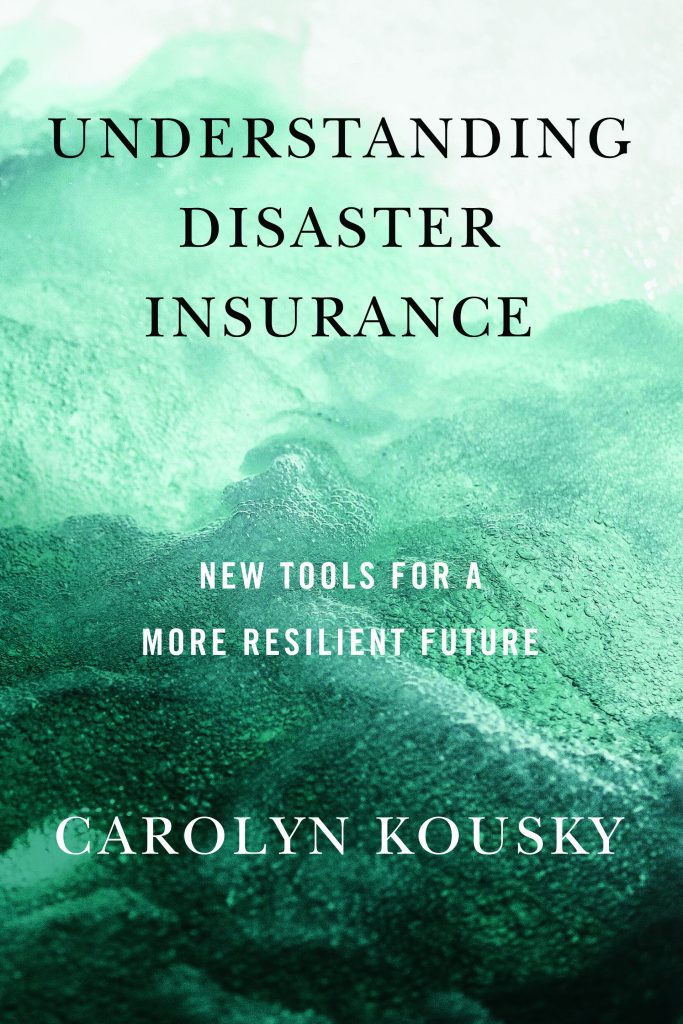Peril in Perspective:New Book Untangles Disaster Risk for Layand Professional Readers

From the first sentence of the first chapter of her new book – Understanding Disaster Insurance: New Tools for a More Resilient Future – Carolyn Kousky nails it: “When it comes to disasters, record-breaking is the new normal.”
Kousky, associate vice president for economics and policy at the Environmental Defense Fund and a Triple-I non-resident scholar, is not engaging in hyperbole when she writes:
“The past few years have seen the largest wildfires on record in places across the globe, from California to Australia. We have seen the earliest formed hurricanes, the strongest storms, the most storms in a year, and the deadliest storm surges. We’ve seen record-breaking rainfall. We’ve experienced the hottest summers, the hottest days, and the hottest nights. We’ve also seen a pandemic sweep the globe, as well as the largest and most sophisticated cyberattack to date.”
If you’re a regular reader of the Triple-I Blog and the Resilience Blog on Triple-I’s Resilience Accelerator website, you’ve already had a sampling of the “new normal” Kousky describes. She is well qualified to explain these complex risks, having previously served as director of policy research and engagement and as executive director of the University of Pennsylvania’s Wharton Risk Center.
Kousky’s academic work goes deep into disaster insurance markets, disaster finance, climate risk management, and policy approaches for increasing resilience. She has published numerous articles, reports, and book chapters on the economics and policy of climate risk and is frequently cited in mainstream and business media.
And she can write, which — as anyone who has slogged through as many academic papers and insurance trade publications as I have can tell you – is a major differentiator.
Kousky has managed to produce something of a unicorn: a book on disaster insurance that anyone who cares about understanding our increasingly interconnected and disaster-prone world can read and learn from. Rather than dive straight into the deep weeds of modeling, pricing, and reserving, Kousky begins by clearly describing the global disaster landscape, articulating the threats and their costs, and explaining what insurance is – and, perhaps most important, what it isn’t – in terms the lay reader can easily identify with:
“By making regular premium payments – certain small losses – insureds are then protected against big losses by receiving compensation when those losses occur. In this way, you can think of insurance as moving money from the good times, when there are no disasters, to the bad times when a disaster happens. You pay a bit in the good times to receive money in the bad times.”
As to what insurance is not, Kousky writes:
“Insurance is not risk reduction…. It needs to go hand in hand with investments to actually reduce risks. At a household level, it could be upgrading to a fortified roof if you live on the hurricane-prone coast… When risks are reduced, insurance is cheaper, such that risk reduction is a critical complement to insurance. We need both.”
When she does get into the taller grass of insurance market structures and operations, regulations, and technically complex aspects of risk transfer beyond insurance, Kousky gives the reader fair warning.
Insurance professionals might choose to skip over some of the familiar industry history and fundamentals, but I found them interesting and – again, a tribute to Kousky’s writing – not at all painful. Her elaboration on the five “ideal criteria for insurability” and discussion of “thin-tail” versus “fat-tail” risks provides a helpful touchstone for insurance generalists like me.
“Insurability is not a yes/no proposition, but a spectrum,” Kousky reminds us, “from easier-to-insure risks, like auto collisions, to difficult-to-insure risks, like destructive earthquakes and hurricanes, to the almost-impossible-to-insure risks, like war.”
Untangling and quantifying these perils and developing strategies to address them will be at the heart of risk management in a warmer, wetter, increasingly chaotic world.
Kousky’s book does a solid job of describing what is being done, what’s working and what isn’t; the challenges of insurance availability and affordability; the opportunities and limitations of risk-transfer mechanisms; the importance of markets, public policy, and individual initiative; and the promise of innovation.
That is no small accomplishment.




